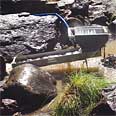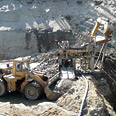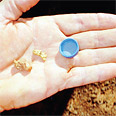All Articles
Legislative and Regulatory Update
May 2008 by Scott Harn
• Forest Service tries to further restrict miningThe US Forest Service is trying yet another time to shut down small-scale mining in National Forests.
On March 25, the USFS proposed changes to regulations governing locatable minerals in National Forests (36 CFR Parts 223, 228, 261, 292, 293) by publishing proposed rules in the Federal Register.
Their intent is clearly to kick prospectors out of National Forests.
The Forest Service wants to create a Bonded Notice category. Included in this category would be prospectors operating dredges, highbankers and similar motorized equipment.
Sleeping in a tent while prospecting would be classified as "occupancy," which would also require a bonded notice. There is no similar rule proposal for other user groups.
Using a motorized vehicle to access the forests would also trigger the requirement for a Bonded Notice if the prospector wants to access any areas that are off of routes approved for use and regularly maintained by the agency. This requirement would also apply to those prospectors who want access to patented property.
They obviously are aware that there are currently no companies bonding small miners. Those wishing to post a bond would need to provide cash or approved government securities.
We don’t have enough space here to adequately cover the proposed rules in the 23-page document. The entire document is available for your review on our website. Click on Pending Rules & Regulations under the Resources tab.
Comments are due by May 27, 2008.
Send written comments to:
Forest Service, USDA
Attn: Director, Mineral and Geology Management (MGM) Staff, (2810)
Mail Stop 1126
Washington, DC 20250-1125
Fax comments to: (703) 605-1575
Email comments to:
36cfr228a@fs.fed.us
For more information, contact Mike Doran, Minerals and Geology Management Staff, (208) 373-4132.
We have been in contact with Jerry Hobbs, president of Public Lands for the People. There are many sections of the proposed rules that conflict with existing laws, specifically the 1872 Mining Law. Another lawsuit against the Forest Service will likely be necessary and PLP is willing to take the lead role if they receive sufficient financial support.
For those of you who aren’t familiar with PLP, they are a non-profit organization dedicated to protecting your rights and they welcome tax-deductible contributions. Contributions are accepted through their website at www.plp2.org.
• Bills would set more lands off-limits
The House of Representatives approved HR 2016 on April 9, which would create a 26 million-acre National Landscape Conservation System (NLCS) managed by the Bureau of Land Management (BLM). The Senate is working on a counterpart bill, S 1139.
The American Land Rights Association states the legislation would create Park Service restrictions on BLM lands.
The Wilderness Society sent out an alert to their membership, encouraging them to support this legislation because the restrictions on these lands would create "…our newest legacy to future generations."
Senator Diane Feinstein (D-California) has been preparing an amendment to expand the proposed NLCS to 32 million acres by adding the entire California Desert Conservation Area (CDCA). Approximately 4 million CDCA acres are already included in the bill, but Feinstein would add another 6 million acres.
The Senate is also considering S 2739. This bill consolidated more than 60 individual bills that would create additional wilderness areas, like the 106,000-acre Wild Sky region in the Mt. Baker-Snoqualmie National Forest.
Please contact your congressional representatives and let them know your position on these bills.
Placer Gold in Arizona
Arizona is better-known for copper than for gold, but there are a number of dry placers in the western and southern parts of the state. A prolonged drought at the time of this writing has made the placers the driest they have been in recorded history. A good gold panner can find colors in many gulches and benches, far more than those that have been described in reports.
SB 838 and the Future of Mining in Oregon
The verbage is SB 838 is vague and ambiguous to say the least. As a result, there is quite a bit of misinformation floating around the rumor mills.
Gold at Mercury Mines
.jpg) There are numerous old mercury (quicksilver) mines in the central Coast Ranges of California, from San Benito County on the south to Lake County on the north, a distance of 225 miles.
There are numerous old mercury (quicksilver) mines in the central Coast Ranges of California, from San Benito County on the south to Lake County on the north, a distance of 225 miles.
Dredging Alternative: High Banking
 The hope was that a bit of the gold from that famous old pocket mine had worked its way down the slope of the hill and into the gravels Pat and his crew were planning to mine.
The hope was that a bit of the gold from that famous old pocket mine had worked its way down the slope of the hill and into the gravels Pat and his crew were planning to mine.
Uphill Battle Continues for California Dredgers
There are currently three controlling agencies or entities over suction dredging in California—and you can make that four if the state legislature decides to further muddy the waters with additional legislation to block suction gold dredging in the state.
Placer Mining in Canada's Yukon Territory
 Frank Taylor’s family has been mining in the same area of the Yukon Territory since 1935. He’s been working his current placer operation on Duncan Creek near Mayo since 1975.
Frank Taylor’s family has been mining in the same area of the Yukon Territory since 1935. He’s been working his current placer operation on Duncan Creek near Mayo since 1975.
Want to Go to Australia?
 Every year there are large nuggets found by the diligent, and occasionally by the lucky newbie.
Every year there are large nuggets found by the diligent, and occasionally by the lucky newbie.
Subscription Required:
The Bawl Mill
• Ask the Experts—Why doesn't the 1872 Mining Law apply to all 50 states?
• Ask The Experts—Where do I find information about getting paid for raw gold?
• Understanding Geologic Deposit Models
• The Lost Silver Triangle of the Sierra Madre—Part II
• Prospecting for Diamonds
• Avino’s Durango Project
• Success With A Detector
• Horsetail Gold
• The Makorakoza of Zimbabwe—Centuries of Prospecting in Gold-Hosting Dolerites
• Melman on Gold & Silver
• Mining Stock Quotes and Mineral & Metal Prices
Free:








